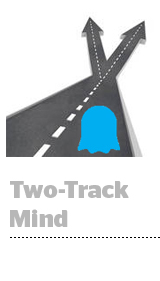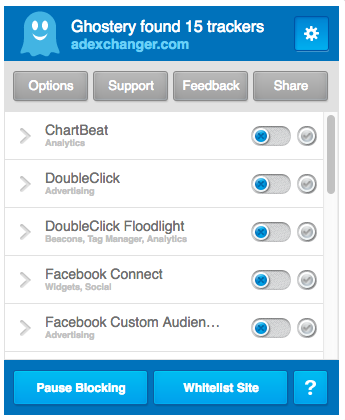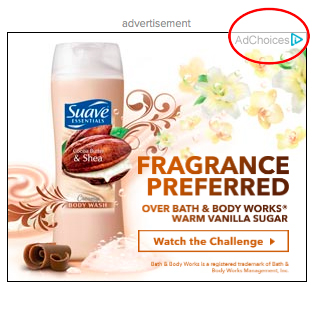 Whether or not Ghostery is an ad blocker depends on how you define “ad blocker.” Also depends on who you ask.
Whether or not Ghostery is an ad blocker depends on how you define “ad blocker.” Also depends on who you ask.
It’s an awkward question for a company that wears two seemingly different hats in the online ad industry.
The first is as one of two primary privacy compliance technology providers powering the Digital Advertising Alliance’s (DAA) debatably toothless AdChoices program. (TRUSTe is the other.) Ghostery works with ad tech vendors to dynamically serve that ubiquitous little blue AdChoices icon into the top right corner of ads across the Internet.
The second is as the maker of a popular browser extension and app that lets consumers manage their preferences around third-party tracking. Users can also choose to block content either across the board or on a case-by-case basis.
Ghostery CEO Scott Meyer vehemently disagrees that Ghostery, née Evidon, is in the same category as Adblock Plus and other unapologetic ad blockers. He’s called the opacity of the Adblock Plus Acceptable Ads program “just a form of extortion,” language echoed by Interactive Advertising Bureau President and CEO Randall Rothenberg at every opportunity.
Meyer also argues that there isn’t any potential conflict in his company’s business model.
But getting paid by ad tech companies on the DAA side while offering a tool that includes ad blocking functionality on the other rubs some industry pundits the wrong way.
“The way I see it, ad tech companies pay a ton of money to Ghostery because it’s involved with the DAA, while Ghostery demonizes the ad tech folks in order to build up the Ghostery [consumer] user base and we – when I say we, I mean the 40 or 50 companies I’ve chatted with about this over the last several years – have a general level of discomfort about this,” said Alan Chapell, president of privacy consulting firm Chapell & Associates and a vice chairman of the Network Advertising Initiative’s board of directors.
But just because the model is a little tricky doesn’t mean there’s anything nefarious going on, said Jim Spanfeller, CEO of Spanfeller Media Group and former CEO of Forbes.com
“They’re probably coming from a well-intentioned place,” Spanfeller said. “But there’s a debate to be had about Ghostery’s tactics.”
In the ad tech industry, there are many such debates to be had.
“Unfortunately, some of the popular business models in the ad industry remind me of John Doerr’s quip about his investment philosophy: ‘No conflict, no interest,’” said Metamarkets CEO Mike Driscoll. “I don’t know if there is a broader lesson here about what kind of business model will be successful in ad tech, but one thing is clear: By charging everybody, you can end up serving no one.”
As Transparent As a Ghost?
Its enterprise privacy compliance business aside, Ghostery packages and sells user data collected through its consumer app and browser extension to advertisers and other companies.
“I don’t think most Ghostery users really understand how that works,” Chapell said.
But for its part, Ghostery is fairly transparent about its data collection practices. When users download the Chrome extension, one of the first things Ghostery asks is for permission to anonymously share their data.
“As you visit a site, Ghostery reveals the trackers on that site and we collect that data,” Ghostery informs its users on a welcome screen after download. “Ghostery sells that data about the trackers to companies who run the sites, enabling them to make their sites more secure and load faster.”
Consumers, however, can also use the Ghostery extension to pause third-party tracking and block scripts, effectively blocking ads on the page.
 And that’s really the crux of the matter – consumer choice.
And that’s really the crux of the matter – consumer choice.
Meyer balks at Ghostery being classified as an ad blocker because, unlike the other blockers on the block, “it blocks nothing by default.”
“The consumer configures Ghostery to work with the specific websites they visit and the types of data collection they feel comfortable with at the time,” Meyer said. “Less than 20% of Ghostery users block all the scripts in our library all the time [and] while Ghostery can be used to block the scripts that deliver ads, that is a byproduct of the solution, not the core value of it.”
Chapell begs to differ.
“It’s a somewhat self-serving definition,” he said. “Yes, Ghostery doesn’t charge money to allow things to get through, but I don’t think that passes the sniff test anymore.”
Blocker Or Not?
There was that ever-so-brief moment in time last September during the height of the iOS 9 content-blocking frenzy when Ghostery collaborated with Tumblr co-founder Marco Arment to power an actual ad blocker called Peace.
Despite Peace almost immediately becoming the top paid iOS app in the US, Arment ended up removing it from the App Store after just two days.
At the time, Meyer called what happened with Peace “an eye-opening experiment,” noting in a blog post that “both we and Marco feel that the way Peace was being used compromised the neutrality Ghostery is built on.”
It’s hard to imagine in what other way a content blocker would ever be used other than to block content, but Meyer told AdExchanger that it was originally presented to Ghostery as an opportunity to collaborate on a consumer choice tool.
What it boils down to is whether you can get behind Ghostery’s stated mission of helping the industry clean up its act while giving users the tools to whitelist the sites that get it right and to block tags – for advertising, analytics, beacons, widgets – on the ones that don’t.
But from another perspective, it’s a business built around asking users to manage their own privacy, both on the enterprise and the consumer side, which may be a lost cause, considering that roughly half of Americans don’t even know what a privacy policy is.
Regardless, Chapell called the Ghostery model an “opportunistic” cash grab that plays both ends against the middle.
Ghostery does indeed have a delicate dance to dance. But that’s the path it’s chosen for itself. So have others. The online ad industry is full of pivots and stuff that happens in the back end –DSPs becoming SSPs, publisher tools branching out to the buy side, frenemy partnerships, data deals.
“It’s challenging to be a consumer-focused tool but also be serving the broader industry and balancing it with business interests at the same time,” said Jason Kint, CEO of publisher trade org Digital Content Next. “But this isn’t unique to Ghostery. A lot of companies wear multiple different hats.”
Hobson’s Choice
The more lucrative hat is certainly the one that Ghostery dons for its ongoing relationship with the DAA.
There have been criticisms of the AdChoices program in the past, namely that most people don’t know why that little blue icon is there or, even if they do, whether it’s doing anything more than keeping the regulators at bay.
DAA Executive Director Lou Mastria predictably defends AdChoices as offering “a pragmatic approach that gives consumers real choice over the types of advertising they receive while protecting the underlying financial framework for ad-supported content and services.”
Not everyone sees it that way. Before taking the reins as CTO of the Federal Communications Commission, Jonathan Mayer, then a researcher at Stanford, called the AdChoices program a bit of “privacy theater.”
“The AdChoices stuff has not worked and the main reason is because it’s mainly a fig leaf more than anything,” Spanfeller said. “It’s an incredibly onerous process even though the ad tech industry could make it easier.”
Although Ghostery generally likes to position itself as a vocal thought leader, in this case Meyer demurs. We’re just the tech guys, he said, we don’t do policy.
“We are a technology provider to this program and do not influence the level of awareness or criticism that has been directed at it,” Meyer said. “We are helping companies comply with the regulations and policies of the program, but Ghostery is not setting those policies or regulations.”
For what it’s worth, a study conducted in December and released in May on behalf of TRUSTe, the DAA’s other compliance vendor, found that awareness of the AdChoices icon has risen from 37% to 42%. The study surveyed 1,000 adults aged 18-75 in the U.S.
What’s Next?
None of this is to say that Ghostery’s tools don’t work in the sense that they do exactly what they’re intended to do, said Chapell.
“Historically, Ghostery has made good tools – their stuff works – and you can always suggest that someone work with them on the compliance side with a high level of confidence,” he said. “That aside, the ultimate question is, how deep in bed should the industry associations get here knowing what we know about the potential for and the reality of conflict here?”
Ghostery is nothing if not adaptable, though. As the FCC ramps up its privacy push around Internet service providers, Ghostery is starting to angle for the creation of what sounds a heck of a lot like AdChoices for ISPs.
“We have millions of people who use Ghostery to manage their preferences inside of their browser, making decisions on the site they are on, the type of technology and other options,” Meyer wrote on the Ghostery blog in April. “We’re in discussions with leading ISPs and mobile carriers to bring this solution to the network level.”
But hey, Ghostery is a private business and that’s what businesses do – they try to suss out new monetization strategies. If there’s a willing market for whatever a company offers, it’s hard to fault it for chasing the revenue stream. Perhaps it’s just about positioning.
“I acknowledge that Ghostery is a business, but I’m not sure how many users know they are essentially the leading compliance vendor for the digital advertising industry,” Chapell said. “You wouldn’t know that [by] the way the Ghostery app has been marketed over the last few years.”
[Full disclosure: I use the Ghostery Chrome browser extension to see which trackers are tracking me, which I love knowing, but I don’t use it to block content.]















